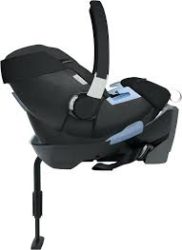This guest article continues SRN’s “Ask an Engineer” series with Dave Sander, CPST-I and engineer (formerly with Evenflo). This series gives an insider view of how CR engineers develop and design CRs, as well as new insights into CR functionality.
Load legs (aka stability legs, foot props) are not a new invention. They’ve been a common feature of CRs for many years in other parts of the world, especially Europe. But in the U.S., load legs continue to be a bit of a novelty and are found only on a handful of (mostly high-end) RF-only CRs. The feature employs an adjustable metal bar that extends vertically from the CR base to the floor of a vehicle to help manage crash force (see photo, left).
In a crash, a load leg limits the CR’s forward rotation, and some CPSTs worry about how that will affect ride-down. As all CPSTs know, a RF CR functions in a crash by having the occupant’s back press into the CR, allowing the force to be absorbed by the CR as it moves toward the point of impact. By virtually eliminating forward movement, a load leg may seem to inhibit the RF CR’s functionality.
So, some wonder: Is it better to allow the CR to move or to stop movement by using a load leg? Well, it is not really a matter of which approach is better; as we all know, every CR on the market must meet the requirements specified in FMVSS 213. But, as one of many approaches to managing crash force, load legs typically do improve overall performance.
It may help to consider that the individual CR performance standards of FMVSS 213 are often at odds with one another: when one facet of performance improves, an opposing facet usually deteriorates. This is true by design, preventing the development of CRs that protect well in one way, while neglecting to consider the increasing likelihood of other types of injury. For instance, it is easy to design a car seat that has an impressive back angle score (the measure of forward rotation) if there is no limitation on maximum HIC (head injury criteria) score or chest Gs. Instead, the various requirements of FMVSS 213 (and the voluntary requirements that many manufacturers place on themselves, as well) are intended to balance performance, ensuring that CRs perform well for the child overall, not merely in one particular way or for one particular type of crash scenario.
To achieve this desired balance in crash performance, many features are employed when designing CRs, and a load leg is one among an array of options.
A load leg’s main effect is to greatly reduce webbing stretch (a concept explored in an article in SRN’s March/April 2018 issue). Seat belts and LA straps are made to stretch when crash force is applied. During a crash test, a CR traveling 30 mph comes to a complete stop in less than a tenth of a second. If the CR has no load leg, it moves forward, stretching the vehicle belt or LA strap while it rotates around the webbing and compresses the seat cushion (the “payout” phase of the crash), and then it slows down to a complete stop (the “ride-down” phase). That is a lot to happen in under a tenth of a second! When a load leg is added to the mix, webbing stretch and the CR rotation are minimized, leaving a little more of the time within that tenth of a second for ride-down.
We are still talking about fractions of a second, but leaving more time for ride-down can make a huge difference. Using an example that might be easier to relate to, imagine driving a car 30 mph and suddenly needing to stop within only 10 feet; you would feel a relatively high force. If, instead, you were given 20 feet to stop, the force is far less severe. This difference is similar to the effect of adding a load leg to a CR. Load legs give more time/distance within that tenth of a second for ride down, because less of the time is spent on payout.
A load leg also limits rebound motion, although the way it does is not as obvious as with other rebound-limiting features, like anti-rebound bars or Swedish-style tethering. In the case of a load leg, rebound is reduced by first minimizing forward rotation in the initial impact. Because the CR hasn’t pushed as hard into the vehicle seat cushion, it does not spring back as much, reducing the rebound aftereffect. Again, this is a result that has to be managed within the allowed limits of various performance criteria in FMVSS 213. The important thing to remember is that all models on the market must meet these performance requirements.
FMVSS 213 requires CRs to meet minimum performance standards without the load leg in use. So all models on the U.S. market with this feature have met NHTSA requirements with the leg in a stowed position, and therefore using the load leg is always optional. If the leg cannot be used according to instructions, perhaps due to characteristics of the seating position where the CR is installed, then follow the CR instructions for installation without employing the load leg.
However, rest assured that all CRs with a load leg do undergo thorough crash testing by their manufacturers with the leg in use. In addition, though FMVSS 213 does not require rear- or side-impact testing at this time, manufacturers typically do voluntary testing of CRs for these types of impacts, and load legs may provide benefits in these crashes, as well.
Bottom line: Remember that all CRs that meet the requirements of FMVSS 213 are safe. Load legs are one of many features that are used by engineers to continuously improve CRs and child safety. However, load legs, like most features, also have drawbacks that must be considered, such as incompatibility with some vehicles. Also, extra CR features can tend to make CR use overwhelming for some users. So, as always, our role as CPSTs is to educate, not dictate.
General Guidance for Using Load Legs
How to Use Load Legs:
In the U.S., load legs are a feature found only on the bases of a few RF-only CR models made by Cybex, GB, Nuna, and Peg Pérego. As manufacturers assess public acceptance of this feature—and its compatibility in vehicles—it is possible that more models will include a load leg in the future.
- Always read the model-specific instructions for use of any CR. However, these general guidelines tend to apply to load leg use:
- Be sure that the bottom of the load leg touches the vehicle floor during use. Many models provide an indicator that confirms when the load leg has made proper contact with the floor.
- Ensure a load leg does not lift the CR off the vehicle seat cushion, as this would diminish crash performance and put the infant in a too-upright position. Check that the parts of a CR’s footprint that would contact the vehicle cushion if the load leg were stowed are making contact when the load leg is in use. It is a good idea to hold the base in place on the seat cushion when extending the leg to touch the floor so that the leg can’t be locked into a position that raises the base. Be sure to instruct caregivers to use this method, as well.
When NOT to Use Load Legs:
Certain vehicle situations prevent use of a load leg. When proper use cannot be achieved, either try a different seating position or install the CR according to instructions for use with the load leg in the stowed position. Watch for these situations that prevent use of a load leg:
- The load leg cannot be made short enough to extend to the vehicle floor without raising the CR base off the vehicle seat cushion. This is most often a problem in center seating positions that have a large hump in the floor to accommodate the vehicle’s driveline.
- The vehicle floor covers a hollow storage area, such as for owner’s gear or a stowed vehicle seat. (This situation is noted for some applicable vehicles in their LATCH Manual model listings in Appendix B. For instance, see Chrysler and Dodge models with Stow ‘n Go foldaway seats. Always check the vehicle instructions, as well.)
- The vehicle seat cushion is too deep for the load leg to drop directly to the floor when the front of the CR base is properly positioned on the vehicle seat cushion. In general, do not move the base away from the seatback (and closer to the cushion edge) in an effort to accommodate a load leg, unless the CR instructions say to do so.


